Monsoons in the Holocene
全新世亞非季風演化: 季節性與大尺度動力 Holocene Afro–Asian monsoon evolution: seasonality and large-scale dynamics
The goal of this research project is to gain a better understanding of the Holocene evolution of the Afro–Asian monsoon, particularly the abrupt and asynchronous changes among monsoon subsystems. A series of data-model synchronous seasonality and regionalization analyses are expected to improve understanding of the Holocene monsoon migration's forcing and response.
The complete studies have been published as journal papers, including the issues (1) Orbital forcing on modulating maritime versus continental monsoons. We studied the influence of precession and obliquity, and we assessed proxy records in the early-to-mid-Holocene and across the mid-Holocene. We also investigated the corresponding changes in the monsoons over a precessional cycle since the last deglaciation; (2) Decadal changes in the current climate; (3) The mid-Holocene evolution of the Afro–Asian summer monsoon circulation and paleoclimate insight into monsoon decadal changes have been provided; (4) Greenhouse modulation of orbital forcing on the monsoons has been investigated. The results may involve near-term climate change.
PUBLICATION
Wu, C. H., S. Y. Lee, J. C. H. Chiang, and P. C. Tsai, 2023: Role of precession on the transition seasons of the Asian monsoon. npj Clim Atmos Sci, 6, 95. https://doi.org/10.1038/s41612-023-00426-y
Wu, C. H., S. Y. Lee, I. C. Tsai, C. J. Shiu, and Y. Y. Chen, 2023: Volcanic contribution to the 1990s North Pacific climate shift in winter. Sci Rep, 13, 5672. https://doi.org/10.1038/s41598-023-32956-z
Wu, C. H., C. J. Shiu, Y. Y. Chen, I. C. Tsai, and S. Y. Lee, 2023: Climatological changes in East Asian winter monsoon circulation in a warmer future. Atmospheric Research, 284, 106593. https://doi.org/10.1016/j.atmosres.2022.106593
Wu, C. H., P. C. Tsai, W. R. Huang, and S. Y. Wang, 2022: Winter-summer contrast of the 1990s decadal change in relation to Afro-Asian monsoons. Climate Dynamics, 59, 1969-1980. https://doi.org/10.1007/s00382-022-06191-7
Wu, C. H., 2021: Seasonal adjustment of particulate matter pollution in coastal East Asia during the 2020 COVID lockdown. Environ. Res. Lett. 16, 124023. https://doi.org/10.1088/1748-9326/ac343c
Wu, C. H., S. Y. Lee, and P. C. Tsai, 2021: Role of eccentricity in early Holocene African and Asian summer monsoons. Scientific Reports, 11, 24089. https://doi.org/10.1038/s41598-021-03525-z
Wu, C. H., and P. C. Tsai, 2021: Impact of orbitally-driven seasonal insolation changes on Afro-Asian summer monsoons through the Holocene. Commun Earth Environ 2, 4. https://doi.org/10.1038/s43247-020-00073-8
Wu, C. H., and P. C. Tsai, 2020: Obliquity-driven changes in East Asian seasonality. Global and Planetary Change, 189, 103161.https://doi.org/10.1016/j.gloplacha.2020.103161
Wu, C. H., P. C. Tsai, and N. Freychet, 2020: Changing dynamical control of early Asian summer monsoon in the mid-1990s. Climate Dynamics, 54, 85-98.doi:10.1007/s00382-019-04989-6
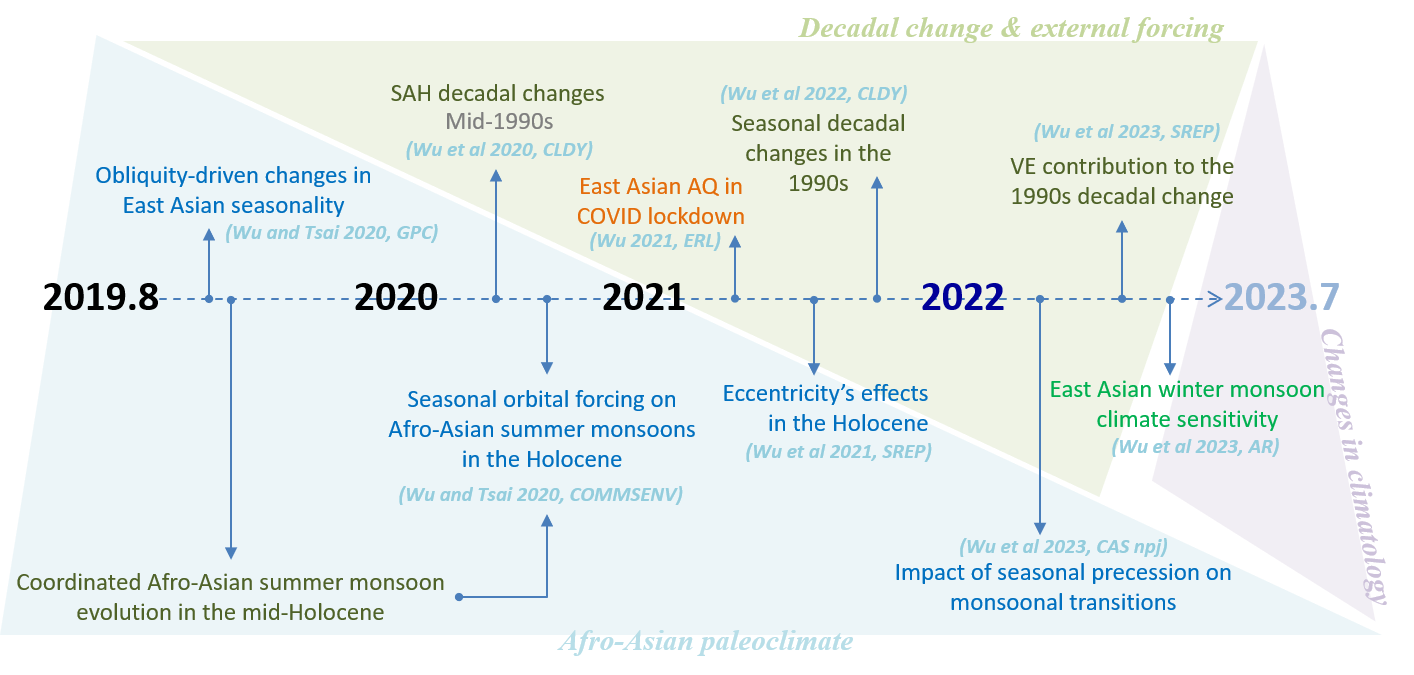
[1] Orbital-scale changes in the maritime versus continental monsoons
[1a] Impact of orbitally-driven seasonal insolation changes on Afro-Asian summer monsoons through the Holocene.
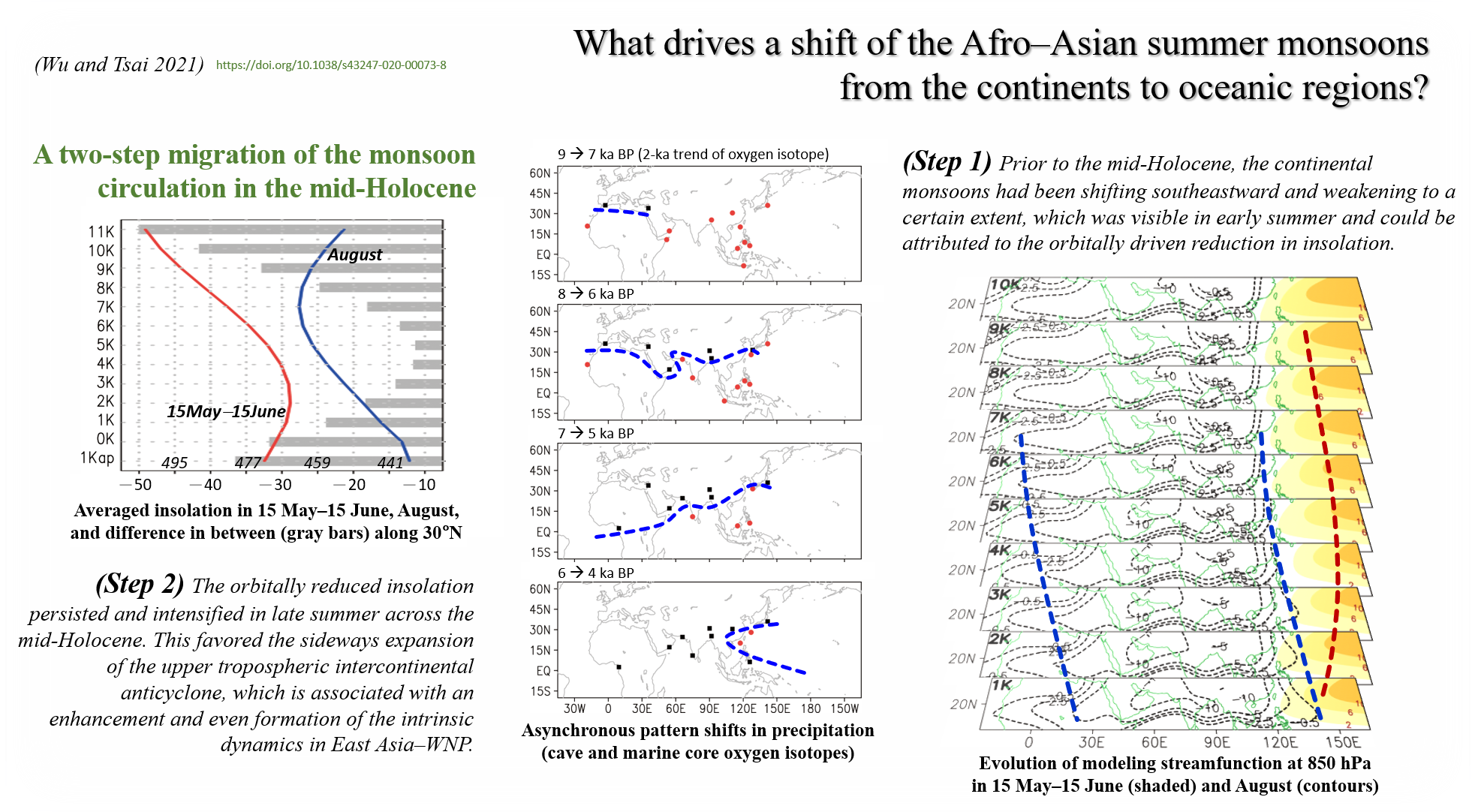
[1b] Role of precession on the transition seasons of the Asian monsoon.
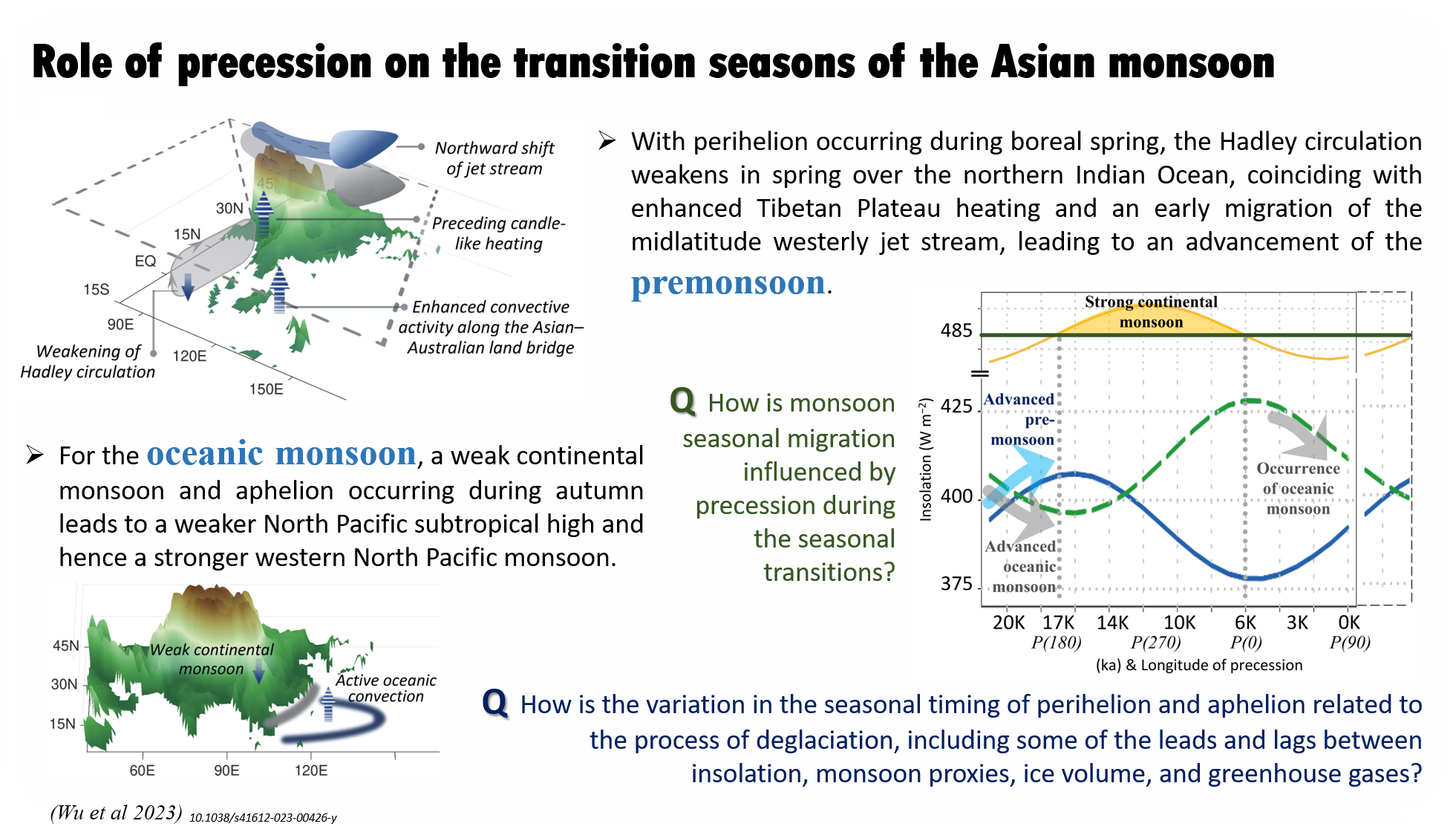
[2] Role of obliquity and greenhouse modulation
Obliquity-driven changes in East Asian seasonality.
Obliquity, as a factor controlling seasonality, has been considered a modulator of paleomonsoon evolution. However, in contrast to the clearly identified contribution of precession, East Asian proxy records rarely provide a robust signal of obliquity. By investigating climate simulations with extremely low versus high obliquity, this study examined the seasonal contribution of obliquity, finding that obliquity has substantial effects on the diversity of precipitation stages over East Asia–Western North Pacific (WNP). The sensitivity of greenhouse gases (GHG) to the effects of obliquity also suggests that the contribution of obliquity could depend on GHG concentrations.
When GHG forcing is weak, summer precipitation migrates following the obliquity-driven meridional insolation changes over Africa, South Asia, and East Asia. In contrast to a condition of high obliquity with a continental origin of the monsoon, summer monsoon precipitation is confined to the subtropical area including the existence of the WNP monsoon trough in low obliquity. The intrinsic dynamic mode over East Asia–WNP, characterized by a meridional dipole pattern in circulation and precipitation, disappears when obliquity is extremely high. In winter, the strength of synoptic scale (the midlevel trough, Siberian high, and Aleutian low over and around East Asia) and larger scale (midlatitude westerly jet stream and Hadley circulation) circulation is coincidently weaker when compared with that in high obliquity. Obliquity-driven changes over East Asia–WNP are also partly sensitive to GHG concentrations. Furthermore, some major obliquity-driven changes weaken and even disappear when GHG concentrations increase.
[3] Role of obliquity and greenhouse modulation
Role of eccentricity in early Holocene African and Asian summer monsoons.
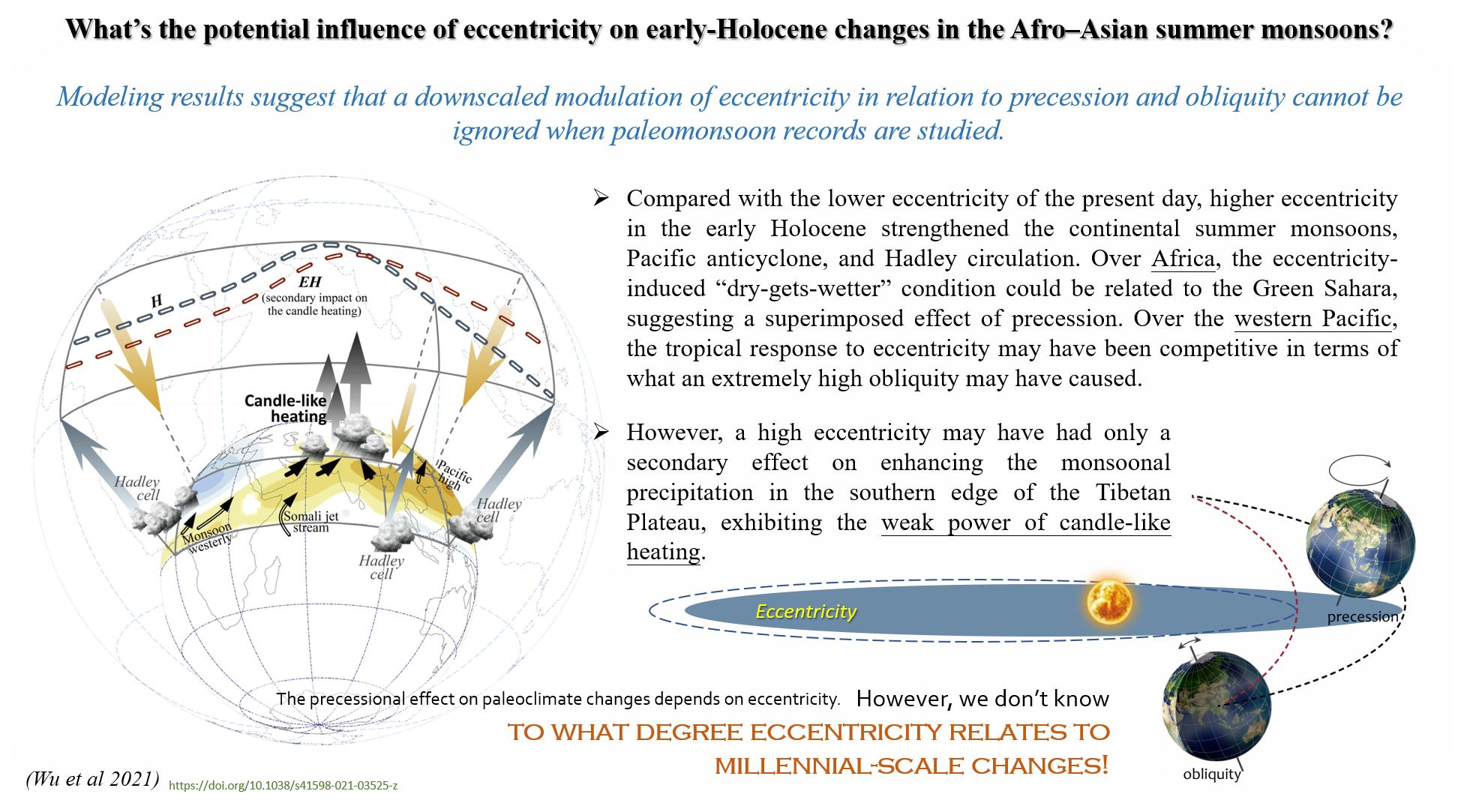
[4] Role of obliquity and greenhouse modulation
[4a] Changing dynamical control of early Asian summer monsoon in the mid-1990s.
The seasonal evolution of the upper tropospheric South Asian high follows and influences underlying summer monsoon advancement. A strong connection between the South Asian high and westerly perturbation to the north suggests further planetary-scale dynamical control of the monsoon. In the mid-1990s, a clear location shift of the South Asian high in May–June was noted and was observed in fewer (more) frequencies of the high centers over the Indochina Peninsula (Iranian Plateau). Continental confinement of monsoonal circulation and precipitation was observed during 1995–2010, as opposed to larger-scale development in the Asia–Pacific region during 1979–1994. In view of early-summer monsoon evolution, a westward shifting and faster migration of the South Asian high may imply increased control of the midlatitude dynamics. By contrast, the convection over the tropical Western North Pacific (WNP) has an opposite and delayed contribution to monsoon advancement. After the mid-1990s than it had been previously, the midlatitude jet stream largely weakened over northern Africa and the East Asia–Pacific region, corresponding to an increase in the upper tropospheric geopotential heights north of the jet stream. Climate model experiments further reveal that the warming over Europe–Asia and temperature change in the North Atlantic can result in the change in midlatitude perturbations and the monsoon evolution in the mid-1990s, suggesting large-scale and dynamic impact on monsoon climatology.
[4b] Winter-summer contrast of the 1990s decadal change in relation to Afro-Asian monsoons.
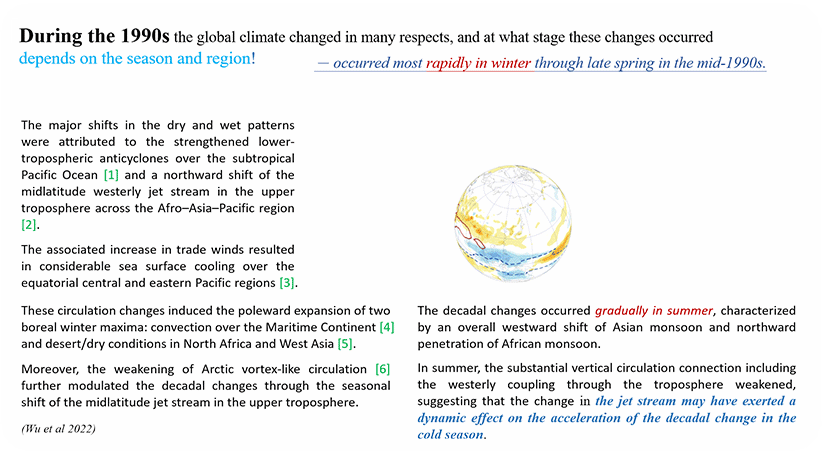
___
[4c] Volcanic contribution to the 1990s North Pacific climate shift in winter.

___
[4d] Seasonal adjustment of particulate matter pollution in coastal East Asia during the 2020 COVID lockdown.
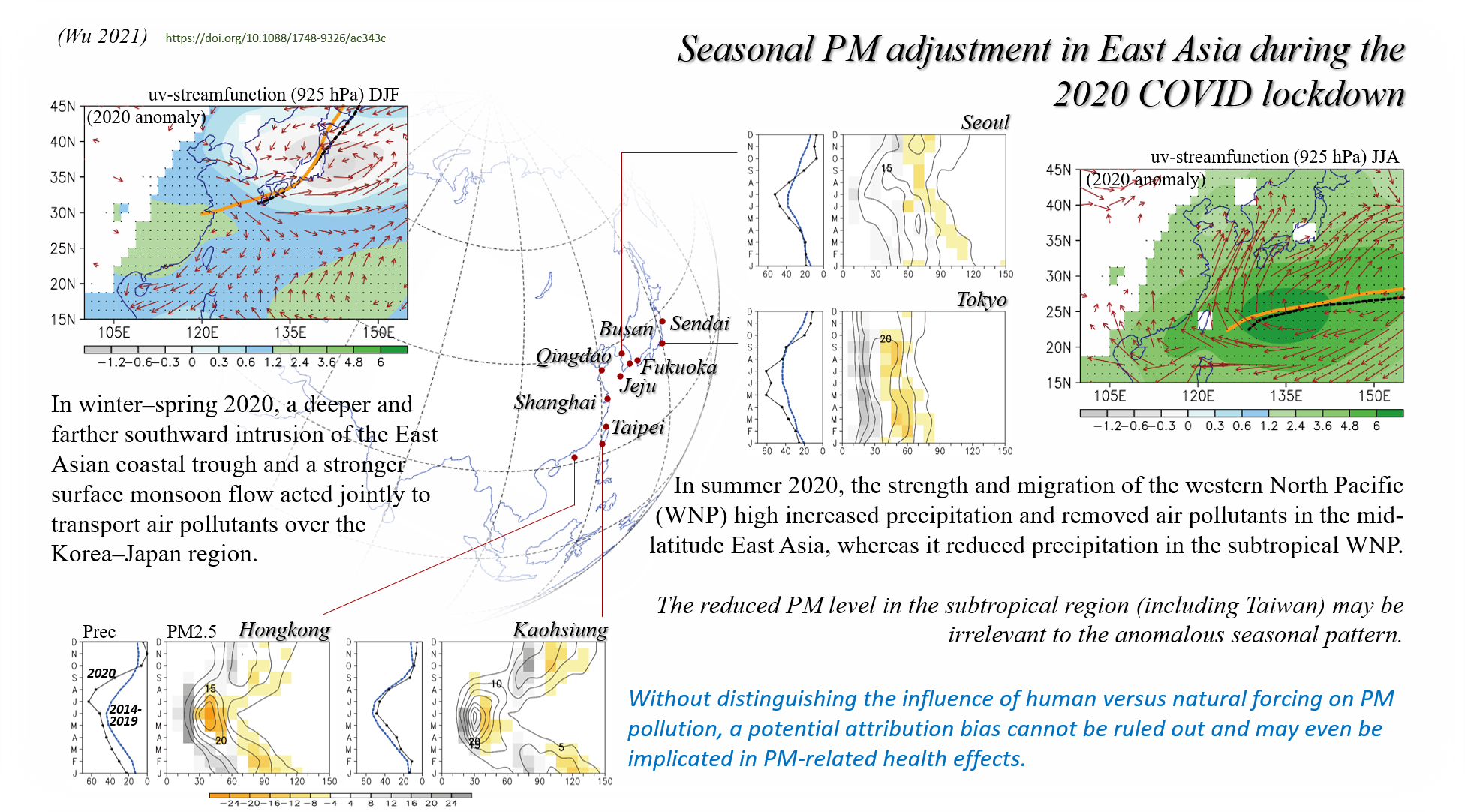
___
[4e] Climatological changes in East Asian winter monsoon circulation in a warmer future.
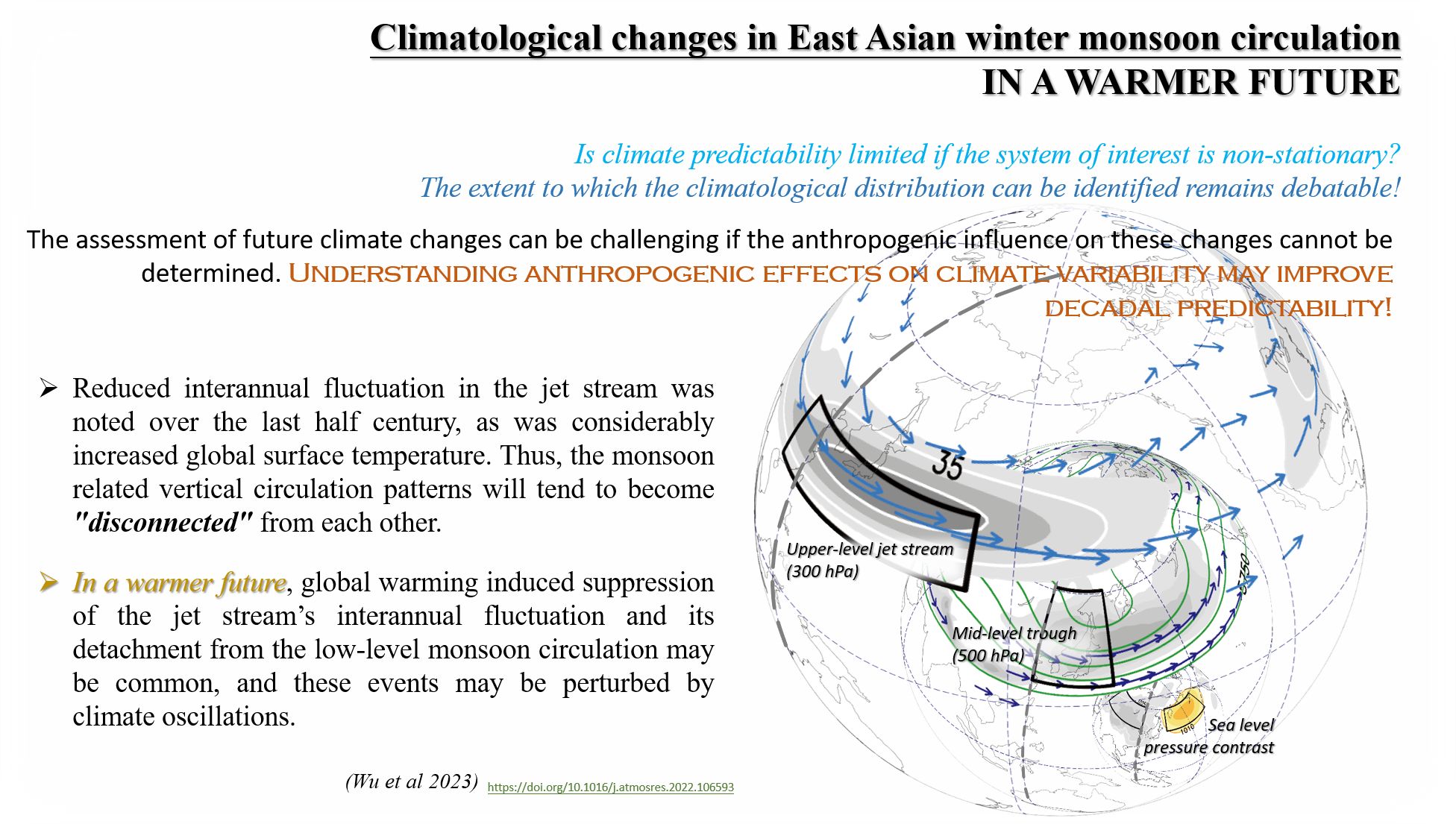
Inspiration for future research:
The project's reviewer made an insightful comment about how we can use our knowledge of paleoclimate evolution to improve future projections. This concern has been incorporated into the sensitivity study, as well as the impact of obliquity on the near future.
Given the link between subtropical changes and seasonal dynamics across latitudes, understanding how the zonal distribution of subtropical dry-wet patterns, including monsoon-desert coupling, could be remapped may provide insight into asynchronous changes in the tropics and polar regions—a bottleneck challenging climate change caused by global warming. We were curious about how the coevolution of the monsoons and subtropical circulation would affect the warming-induced changes in the meridional circulation.
We have identified two promising areas for future study: (i) investigating the potential bias of monsoon decadal dynamics in climate projections, particularly about the monsoon-midlatitude interaction; and (ii) determining the climatological distribution in relation to the large-scale seasonal control of subtropical circulation.